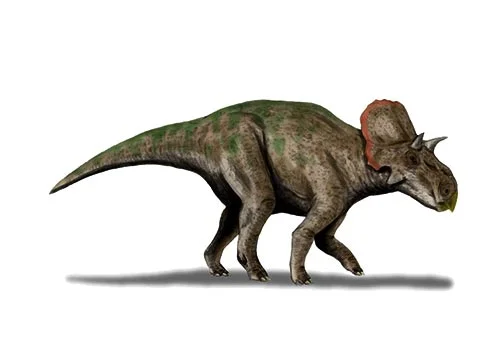Avaceratops (Ava horned face)

A-vah-seh-rah-tops
Peter Dodson - 1986
Herbivore
Estimated 2-3 meters long
Ceratopsian
A. lammersi (type)
USA, Montana - Judith River Formation
Late Cretaceous, 75 million years ago
Avaceratops Facts
Avaceratops, also known as the “Ava horned face,” was a genus of ceratopsian dinosaur that lived during the Late Cretaceous period, approximately 75 million years ago. The genus contains a single species, Avaceratops lammersi, which was first discovered in the Hell Creek Formation in Montana, USA.
Avaceratops was a relatively small ceratopsian, estimated to have measured between 2 and 3 meters in length and weighed around 1 ton. It was a quadrupedal herbivore, meaning that it walked on four legs and primarily ate plants. Like other ceratopsians, Avaceratops was characterized by a large frill at the back of its head, which may have served as a display structure or as protection against predators. In addition, it had two long brow horns above its eyes, as well as a small nose horn.
Avaceratops is significant because it provides valuable insights into the evolution and diversity of ceratopsian dinosaurs. It represents one of the smallest and earliest known ceratopsians, and its anatomy provides important information about the early evolution of this group of dinosaurs. In addition, Avaceratops is an important part of the fauna of the Late Cretaceous Hell Creek Formation, which has yielded a wealth of fossils from a variety of dinosaur and other vertebrate species.
Despite its small size, Avaceratops was a formidable dinosaur that would have played an important role in its ecosystem. Its tough beak and powerful jaws would have enabled it to efficiently feed on tough vegetation, while its large frill and horns would have served as impressive displays and provided protection against predators.
In conclusion, Avaceratops is a fascinating dinosaur genus that provides valuable insights into the evolution and diversity of ceratopsian dinosaurs. Its discovery in the Hell Creek Formation highlights the importance of this region for the study of dinosaur evolution and diversity, and its anatomy provides important information about the early evolution of this group of dinosaurs. I hope this brief overview has sparked your interest in Avaceratops and I encourage you to learn more about this amazing dinosaur genus.



